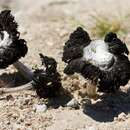en
names in breadcrumbs


This species is well known from the western United States ranging from eastern Oregon to Texas and Baja California, but there are some unclear references to specimens examined in Zeller, S.M., 1943, Mycologia 35(4): 418 from the USSR and Algeria. From searching sites on the web on March 25, 2011 including GBIF, Atlas of Living Australia and INBio I found occurrence records from the US, Spain, Australia and Argentina.
Typically appears as a stiff, woody stalk with a distorted disk-like pileus. The pileus is usually pale on top and black underneath. The bottom of the stalk usually has a bulb and a volva.
Typically in dry, sandy, desert and desert-like habitats.
Can be confused with Podaxis pistillaris which tends to be bigger and have a better defined pileus that looks more like a dried out Coprinus comatus. Both species are closely related to Coprinus comatus.
Montagnea arenaria is a species of secotioid fungus in the family Agaricaceae. Originally named Agaricus arenarius by Augustin Pyramus de Candolle in 1815,[2] it was transferred to the genus Montagnea by Sanford Myron Zeller in 1943. The species is characterized by a cap that has an apical disc, radial gills, a hymenophore, and spores with a prominent germ pore.[3] It is inedible.[4]
Montagnea arenaria is a species of secotioid fungus in the family Agaricaceae. Originally named Agaricus arenarius by Augustin Pyramus de Candolle in 1815, it was transferred to the genus Montagnea by Sanford Myron Zeller in 1943. The species is characterized by a cap that has an apical disc, radial gills, a hymenophore, and spores with a prominent germ pore. It is inedible.